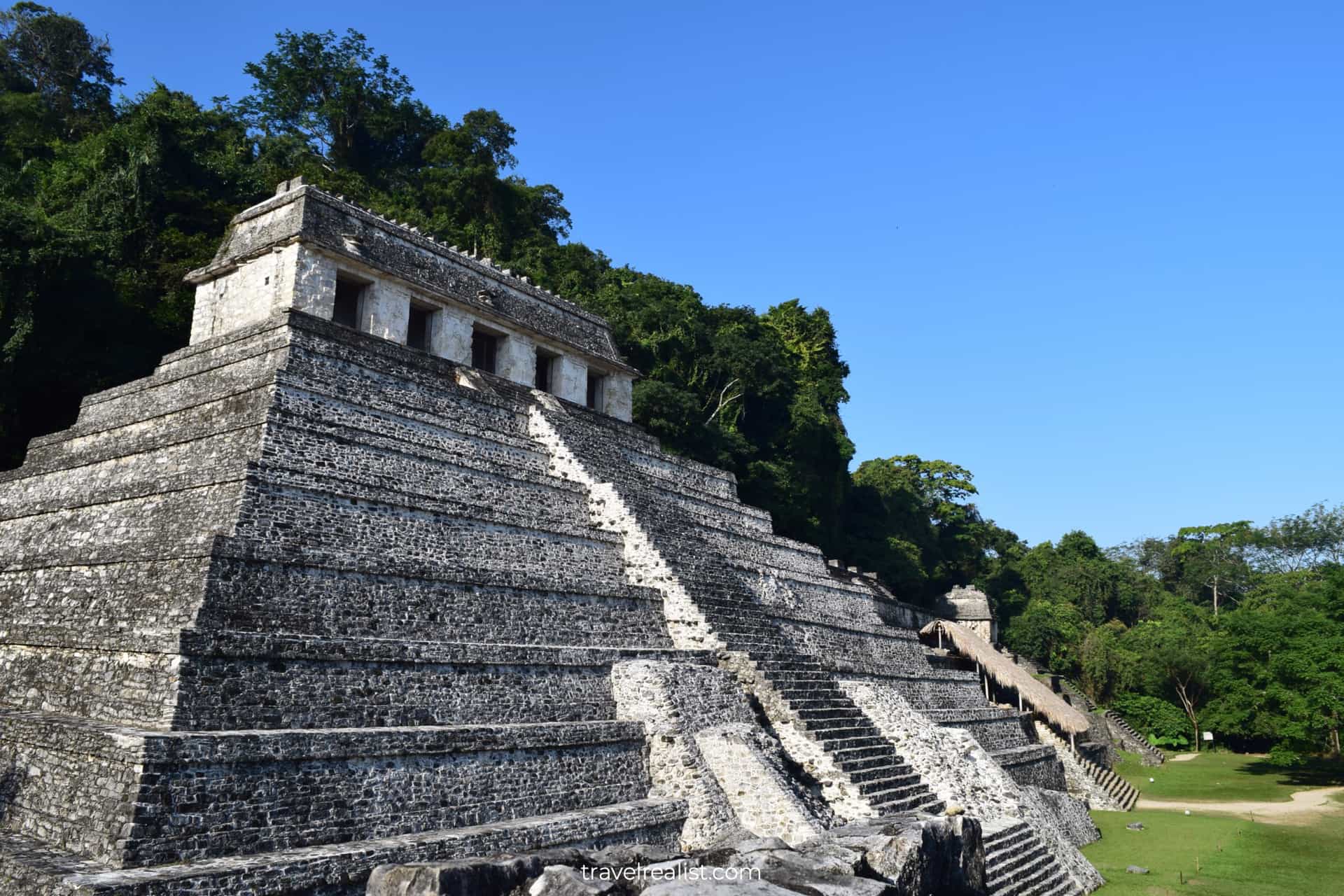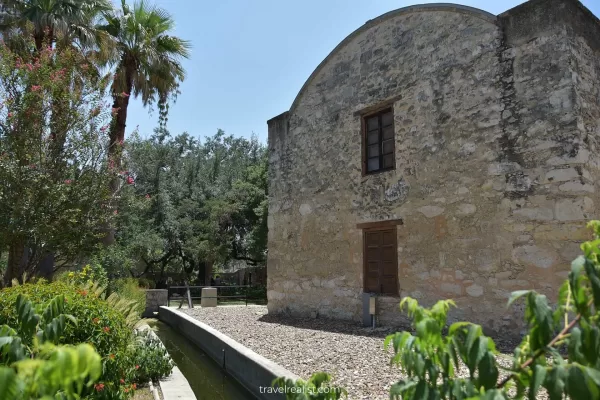Cathedral Gorge: Slot Canyon Better Than Antelope
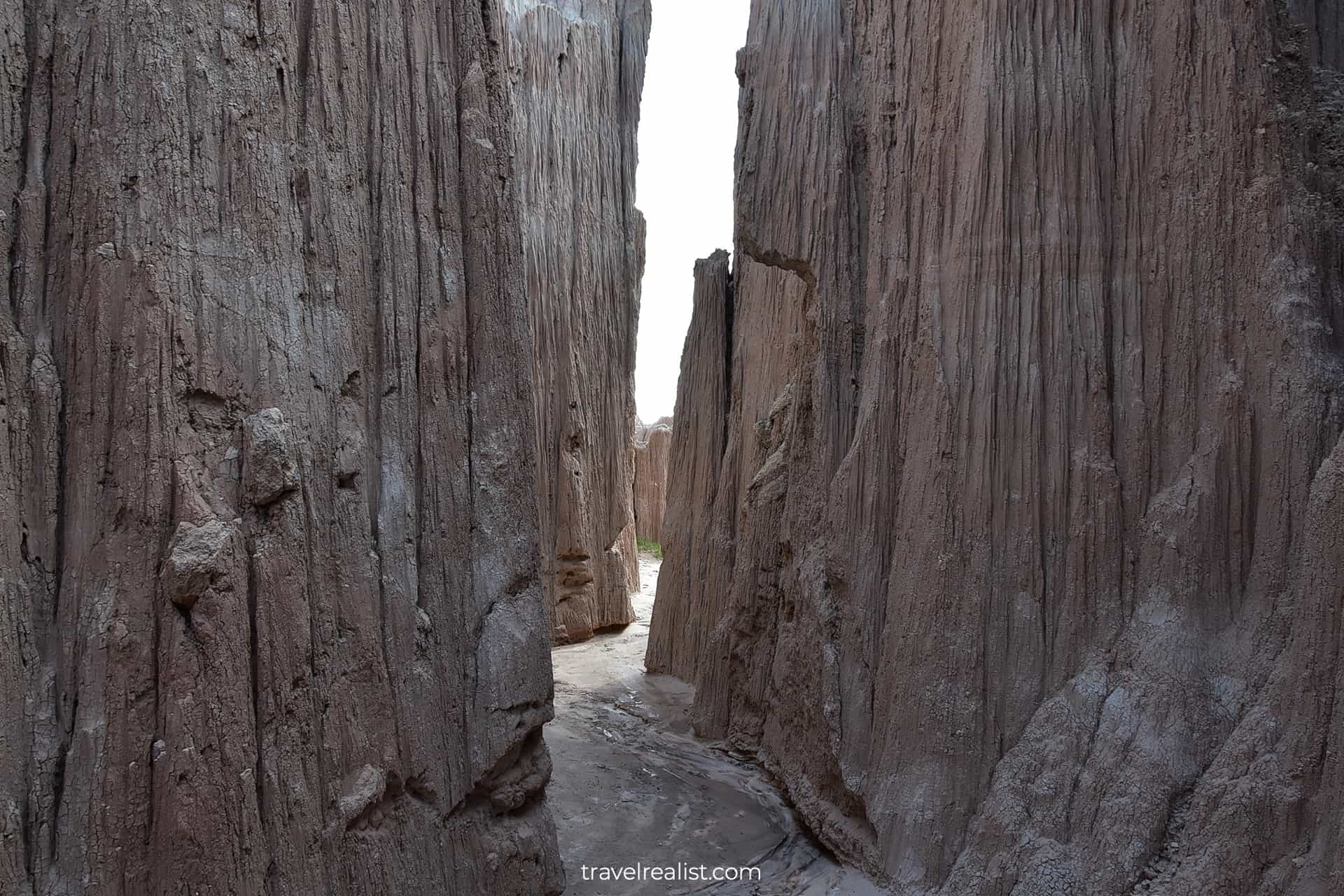
Cathedral Gorge State Park Guide
Use our realistic Cathedral Gorge Guide to plan your next adventure in this state park.
Cathedral Gorge State Park is a Nevada park known for its fascinating slot canyon system and formations.
This post includes affiliate links that will earn us commission if you make a purchase via these links.
Unique clay patterns resemble the famous Antelope Canyon. Yet you can explore Cathedral Gorge without a tour guide, crowds, and at a fraction of the cost.
Sights & Places of Interest
Cathedral Gorge State Park features scenic viewpoints and trails. However, slot canyons or caves are undoubtedly the park’s signature attractions.
This Cathedral Gorge Guide will focus on describing each of the park’s three main slot canyons. We will start with Moon Caves and continue to Canyon Caves and Cathedral Caves.
Moon Caves
Our exploration of Cathedral Gorge’s slot canyons started with the Moon Caves. The Moon Caves were the first caves we saw once we entered the park via the south entrance.
You would not miss these caves since they are located at the very end of the paved road.
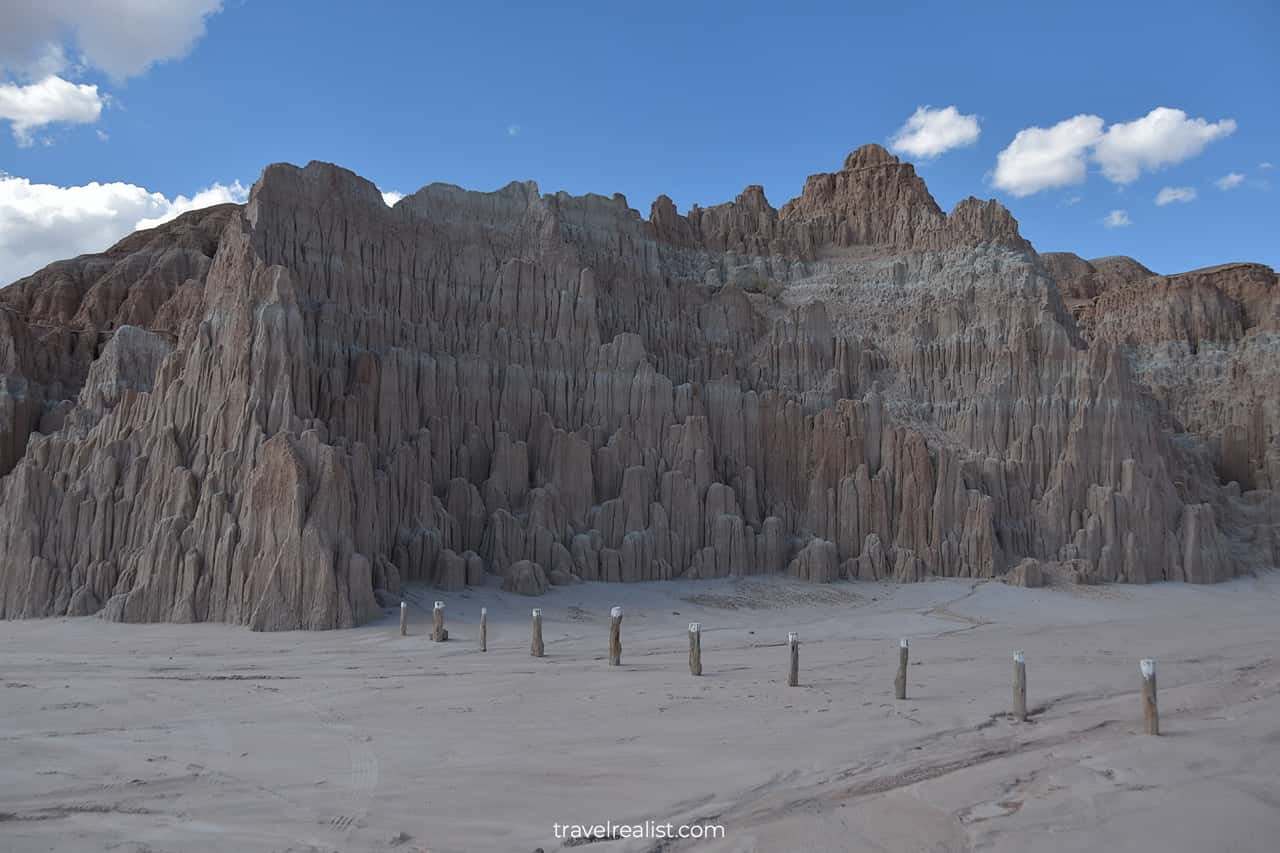
The Moon Caves include two slot canyons with a few offshoots each. You can reach these canyons via separate entrances.
However, finding the entrance is an adventure in itself. Minimal signage brings out an explorer spirit. Pro tip: look for a creek or a wash and follow the path into the canyon.
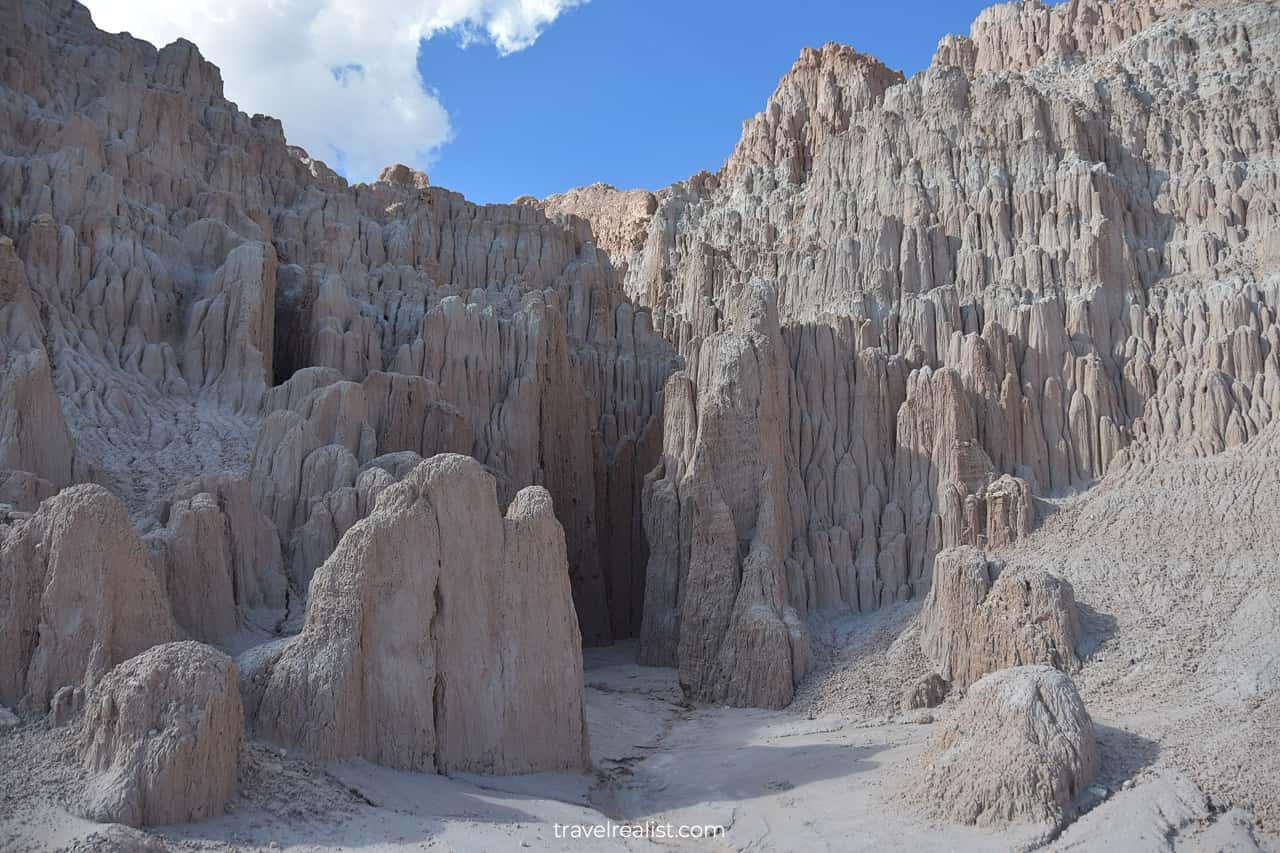
Once inside the Moon Caves, we entered a series of fairly wide passages.
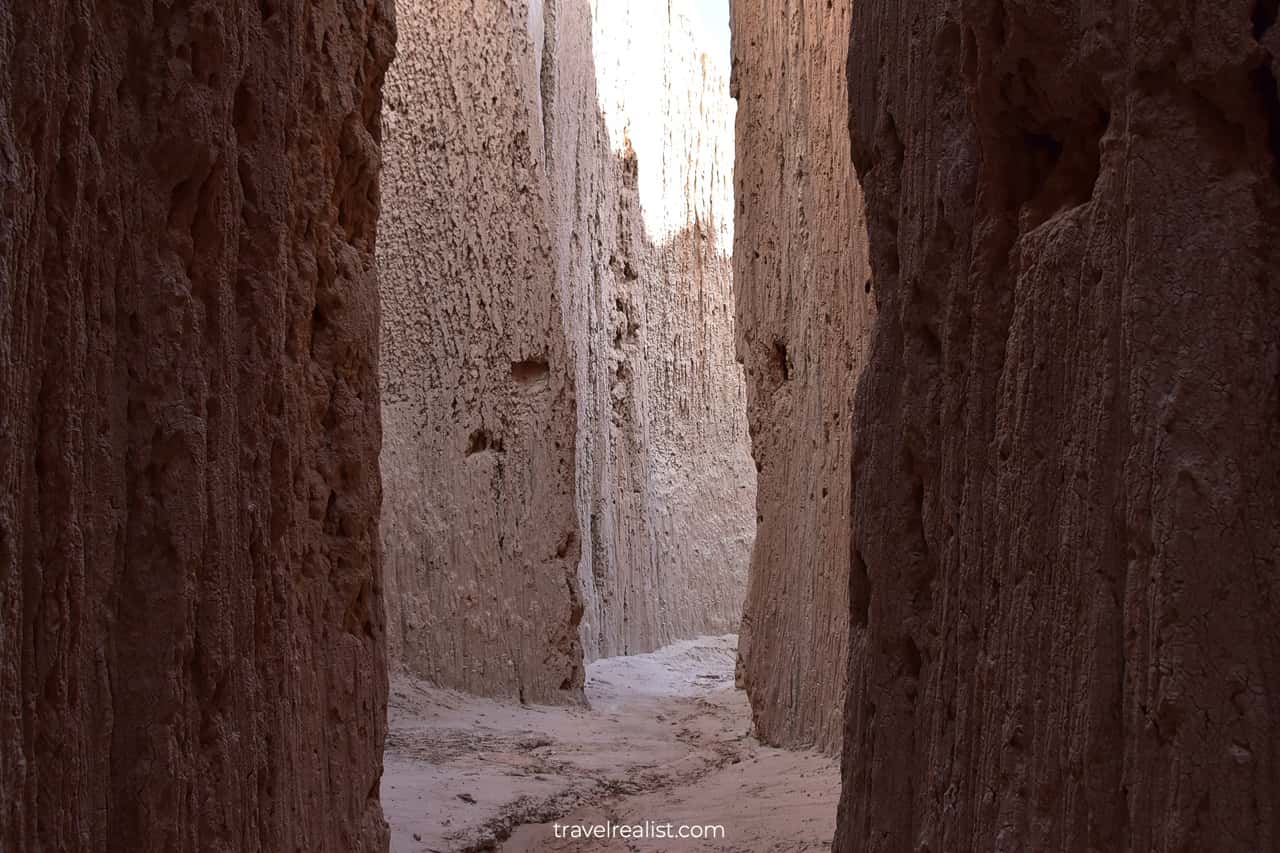
As we proceeded further into the canyon and its offshoots, the passages started to narrow.
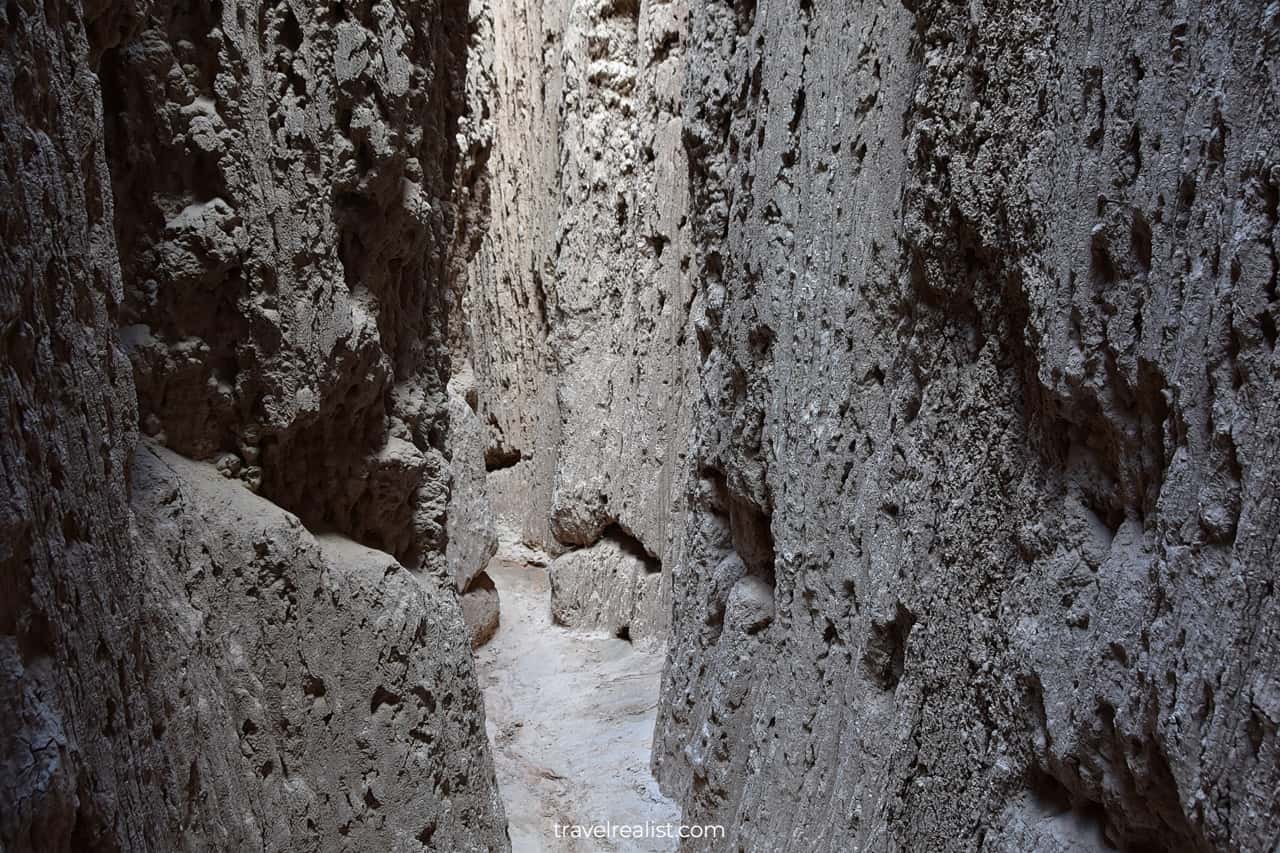
Eventually, the path became so narrow that we had to slow our exploration pace. Be prepared to squeeze between the canyon walls and know your limits if you are claustrophobic.
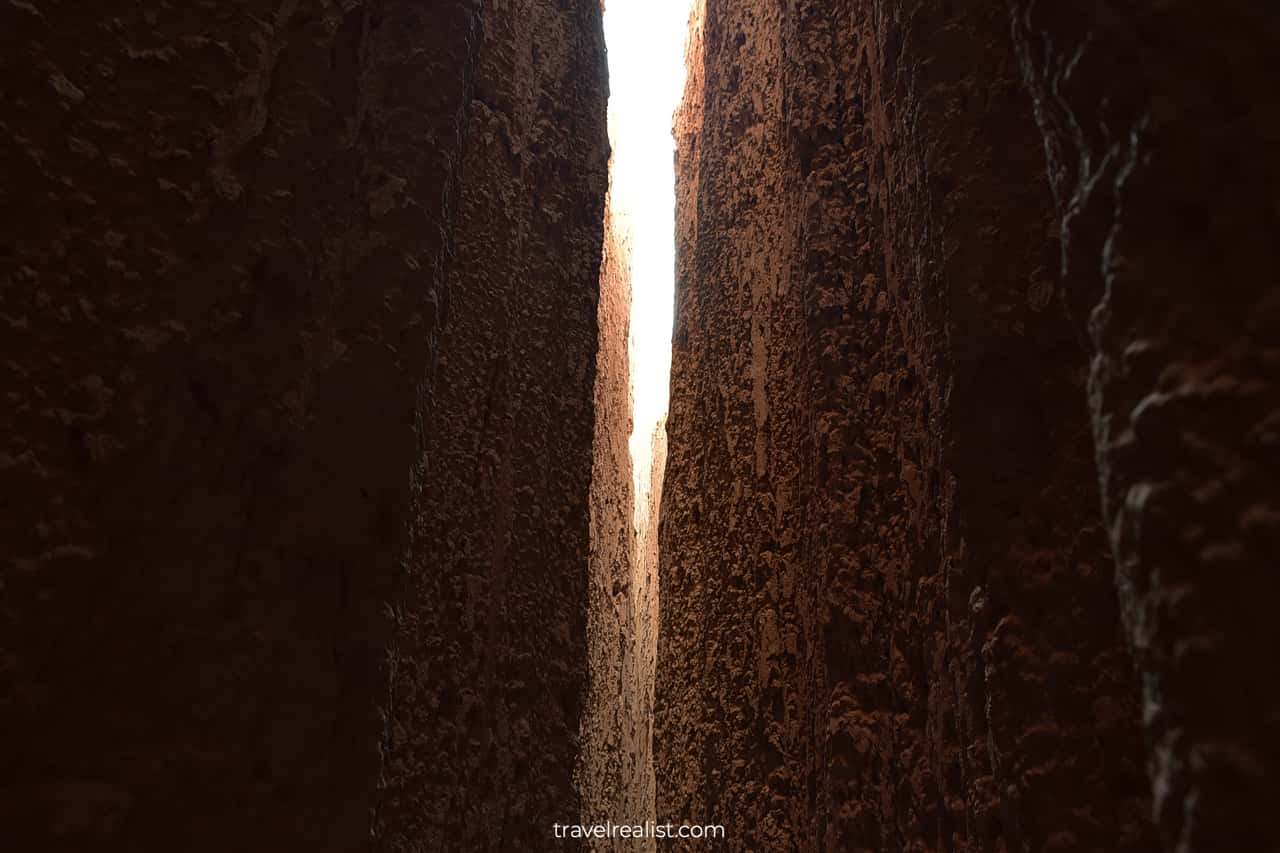
The second of the Moon Caves is further into the canyon. You can easily miss it due to a lack of signs.
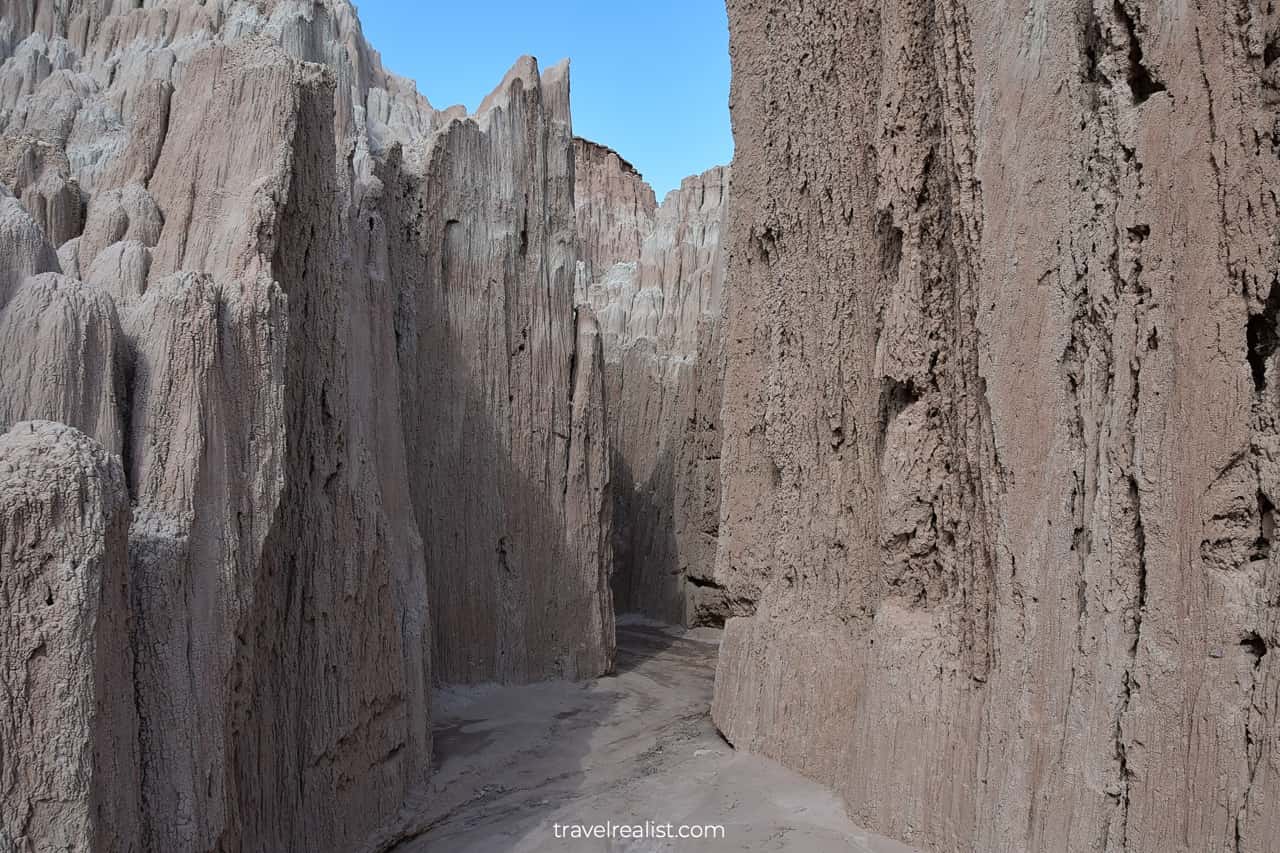
This slot canyon has a nice balance between wide and narrow passages. It also provides some of the best slot canyon views in the entire park due to a clear perspective.
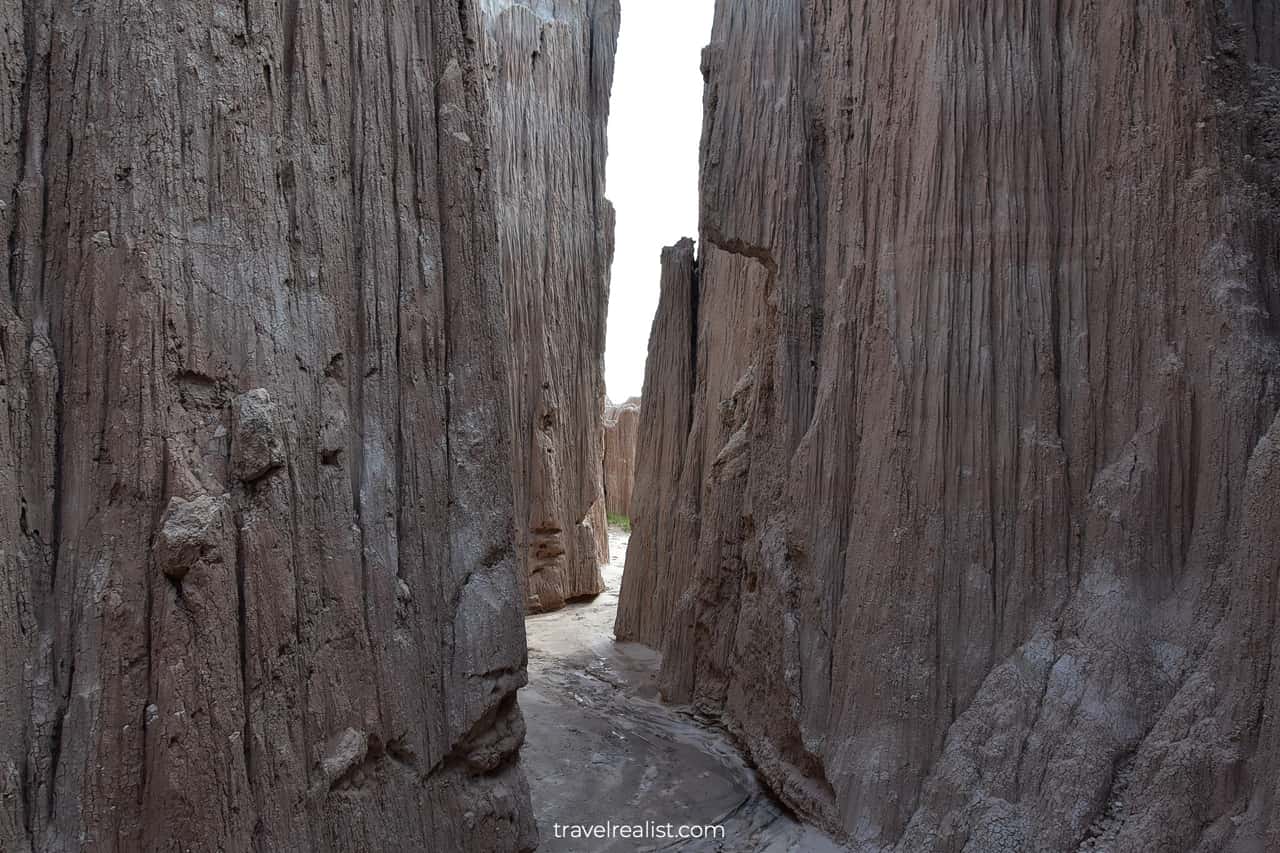
Light and shadows make a world of difference when exploring a slot canyon. See how different the same Moon Cave appeared when the sun came out.
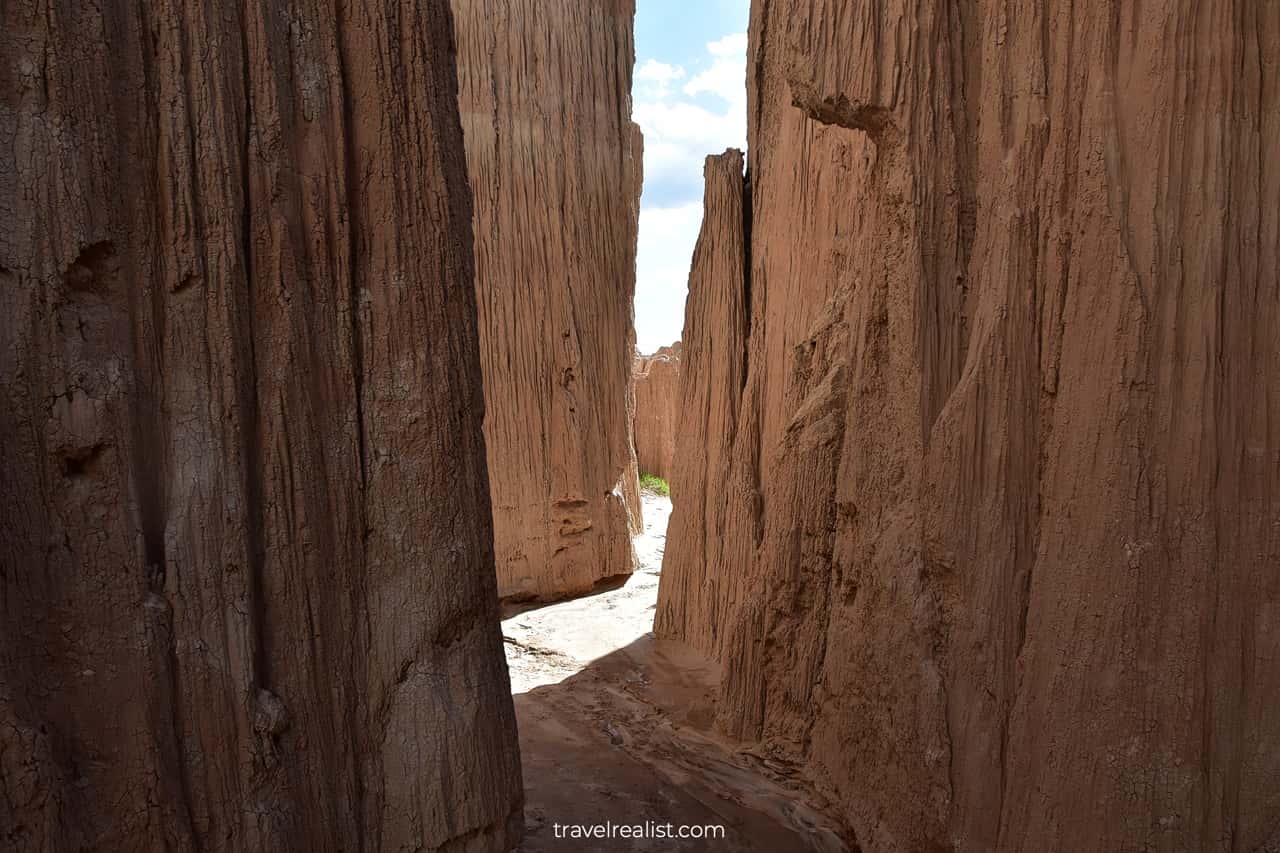
Like most slot caves in Cathedral Gorge, the Moon Caves end in a well like structure. It looks like a cathedral or spire from the outside.
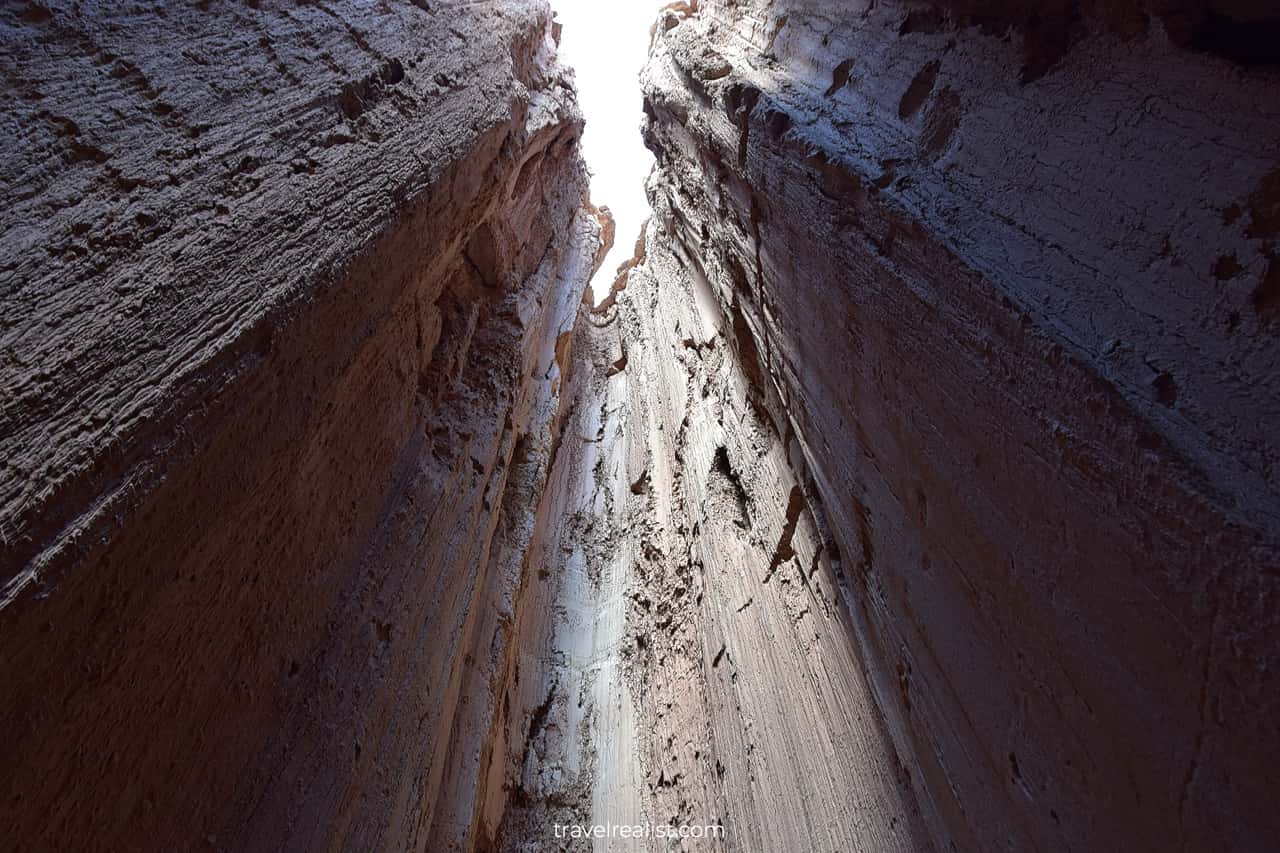
Canyon Caves
Canyon Caves were our next stop in the park. These caves are just a short walk north from the Moon Caves. You can also reach the Canyon Caves by driving 0.2 miles (300 m) on an unpaved road.
Park at a small designated area. The Canyon are a few yards (meters) from the parking lot.
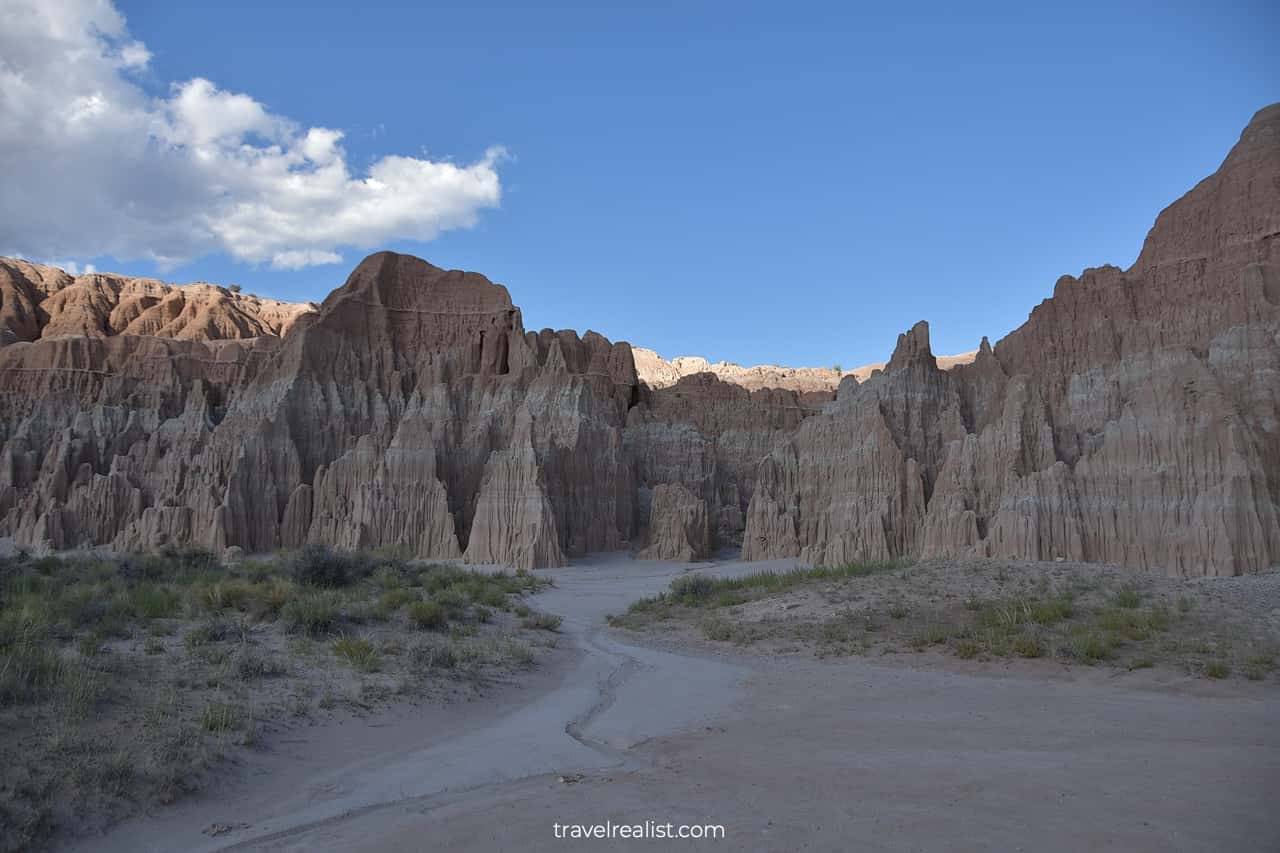
The Canyon Caves are significantly smaller than the Moon Caves. In fact, the Canyon Caves are the smallest of the three canyons in Cathedral Gorge.
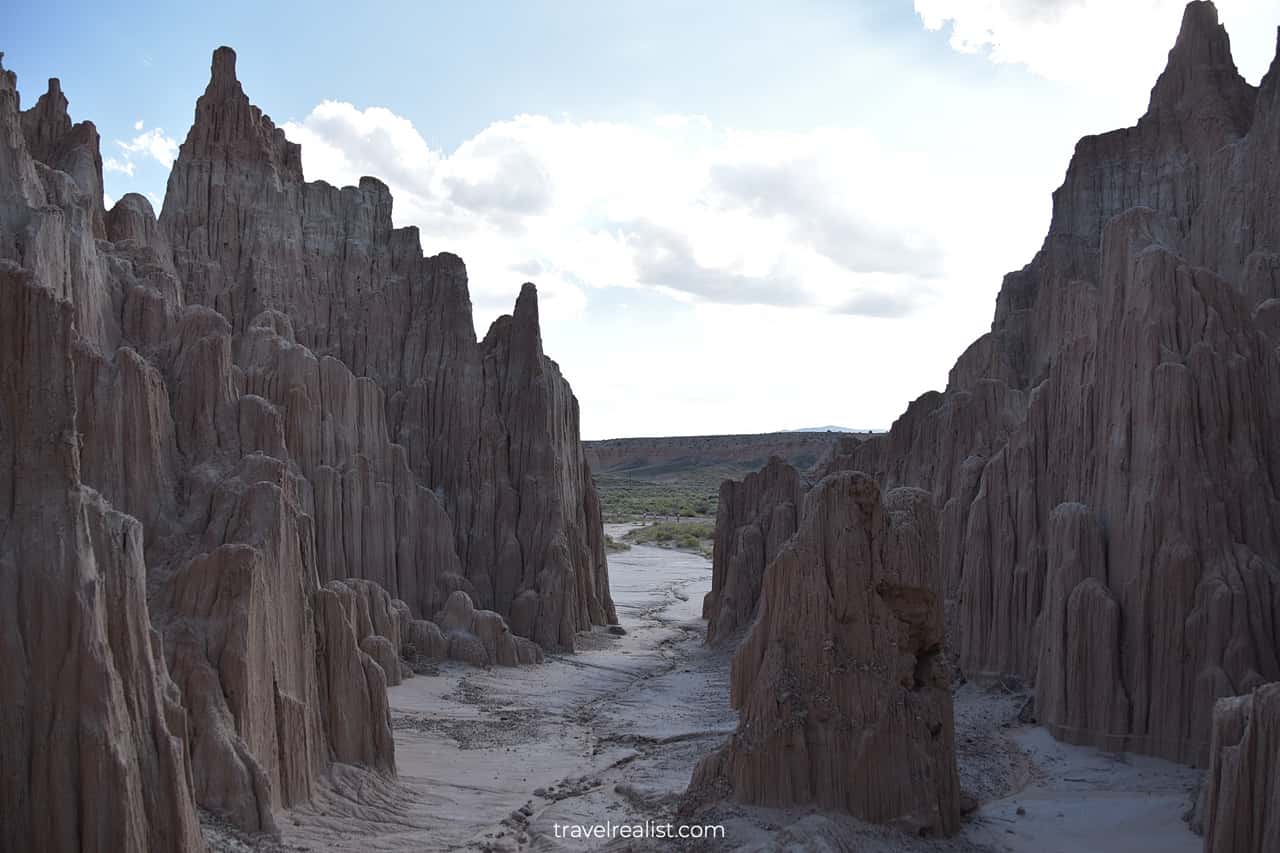
However, the Canyon Caves provided a first close-up view of the cathedral-like spires.
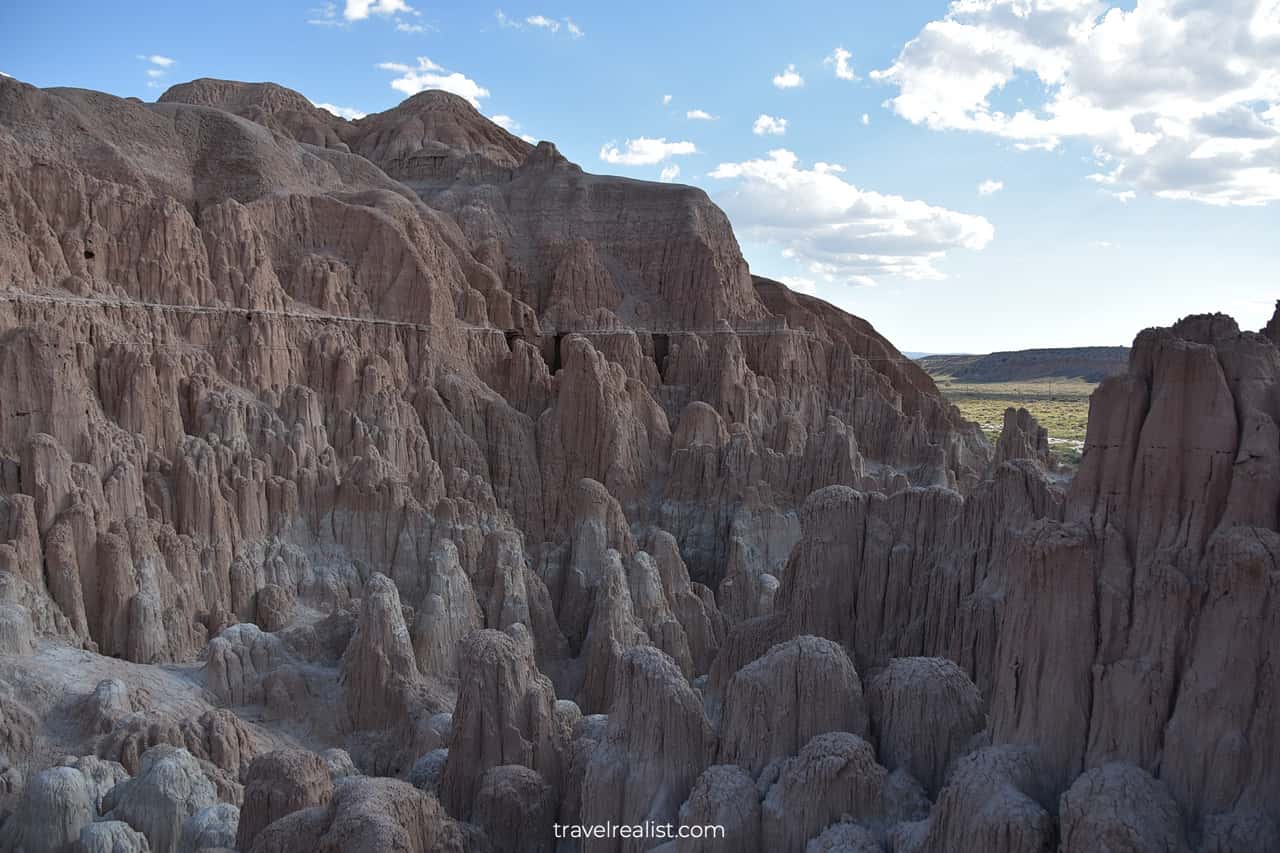
CCC Water Tower
Cathedral Gorge’s next attraction provided us with a quick break from the slot canyons. It featured a two-story Civilian Conservation Corps Water Tower.
The tower was built in the mid 1930s as part of the park’s water system construction. Over time that water system was abandoned due the high alkali content.
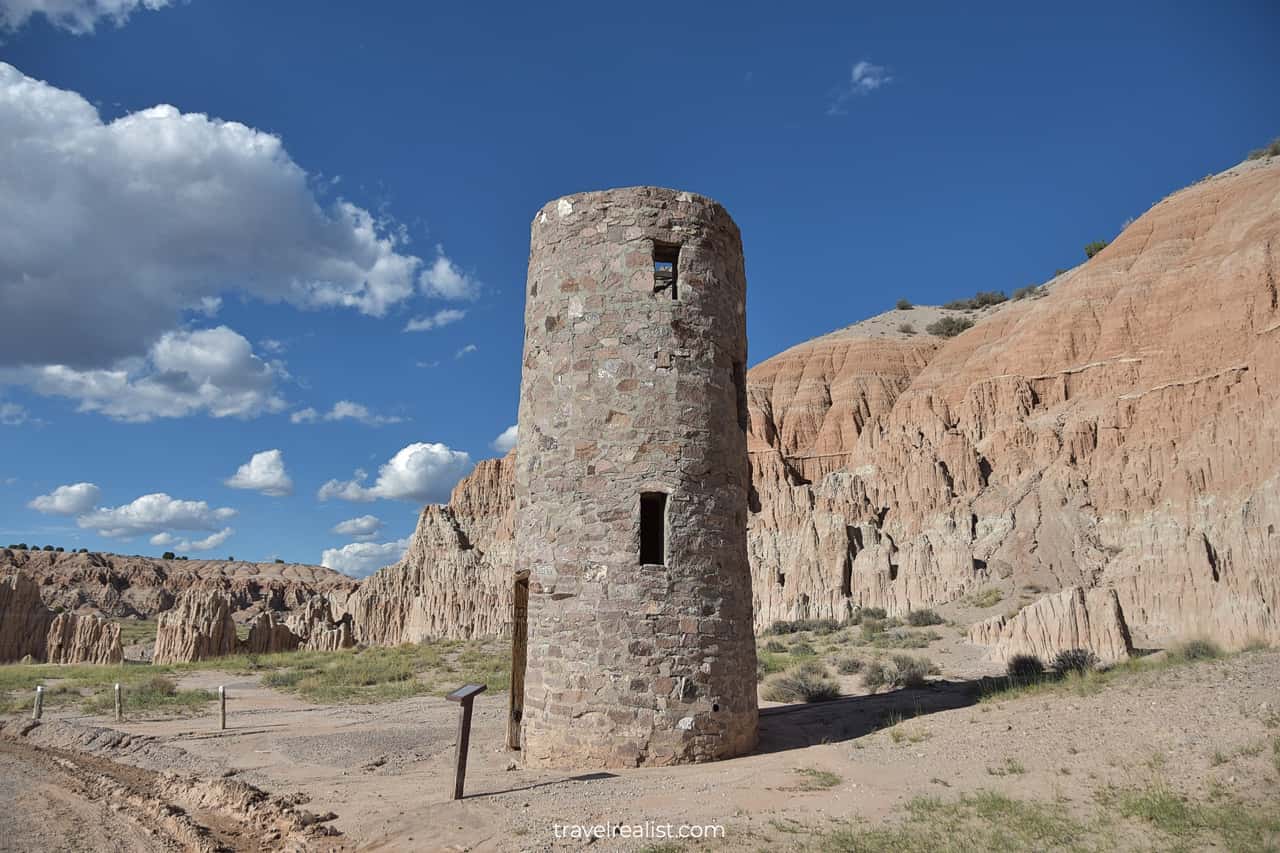
This overlook displays similar slot formations outside of the Water Tower.
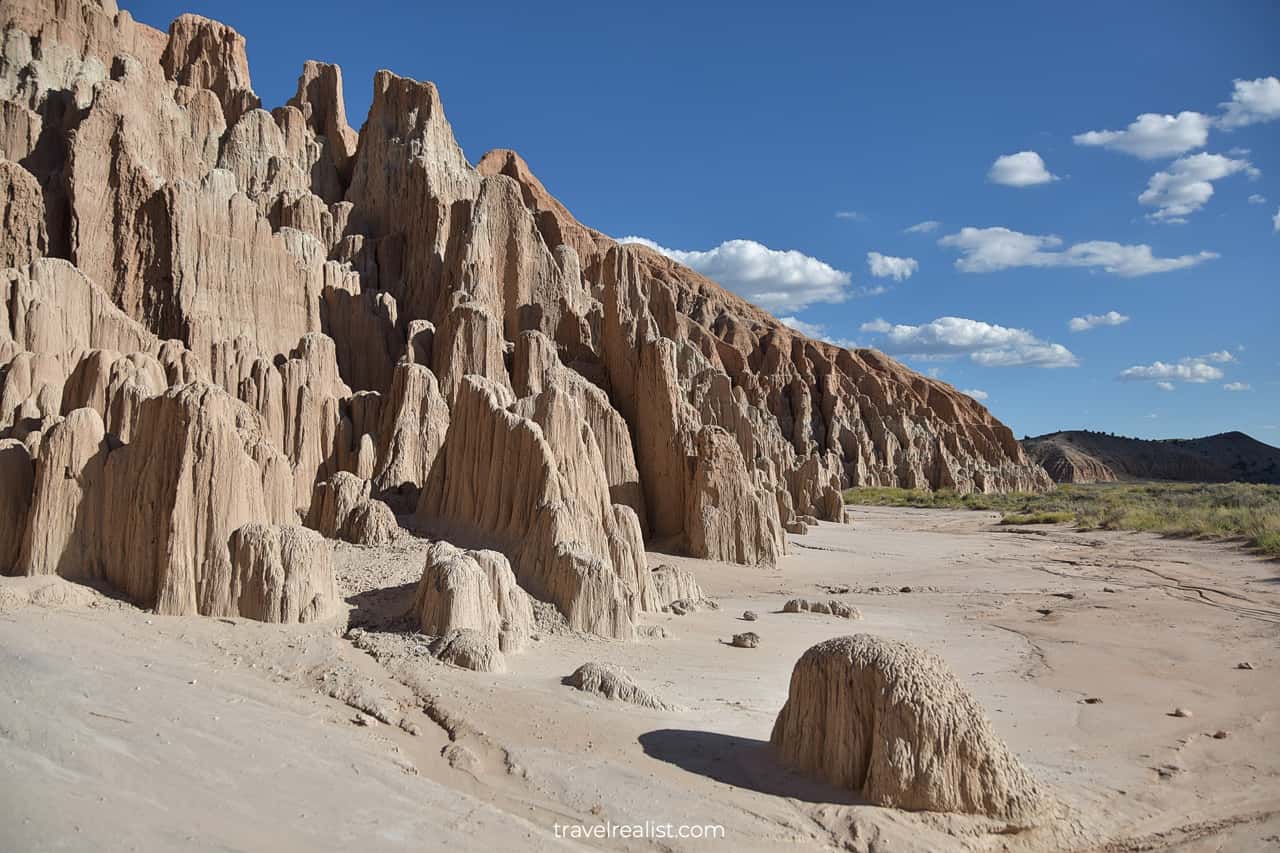
CCC Water Tower also featured mud streams from the rain.

Cathedral Caves
The Cathedral Caves, the third and final slot canyon system, gave the name to the whole park. These caves are very easy to spot due to several reasons.
- First, the Cathedral Caves are at the end of the unpaved road, next to the Miller Point and Nature Loop.
- Second, the canyon’s entrance is just behind the CCC Day Use Picnic Area, the lone shade providing structure.
- Finally, these caves feature a natural tower like formation.
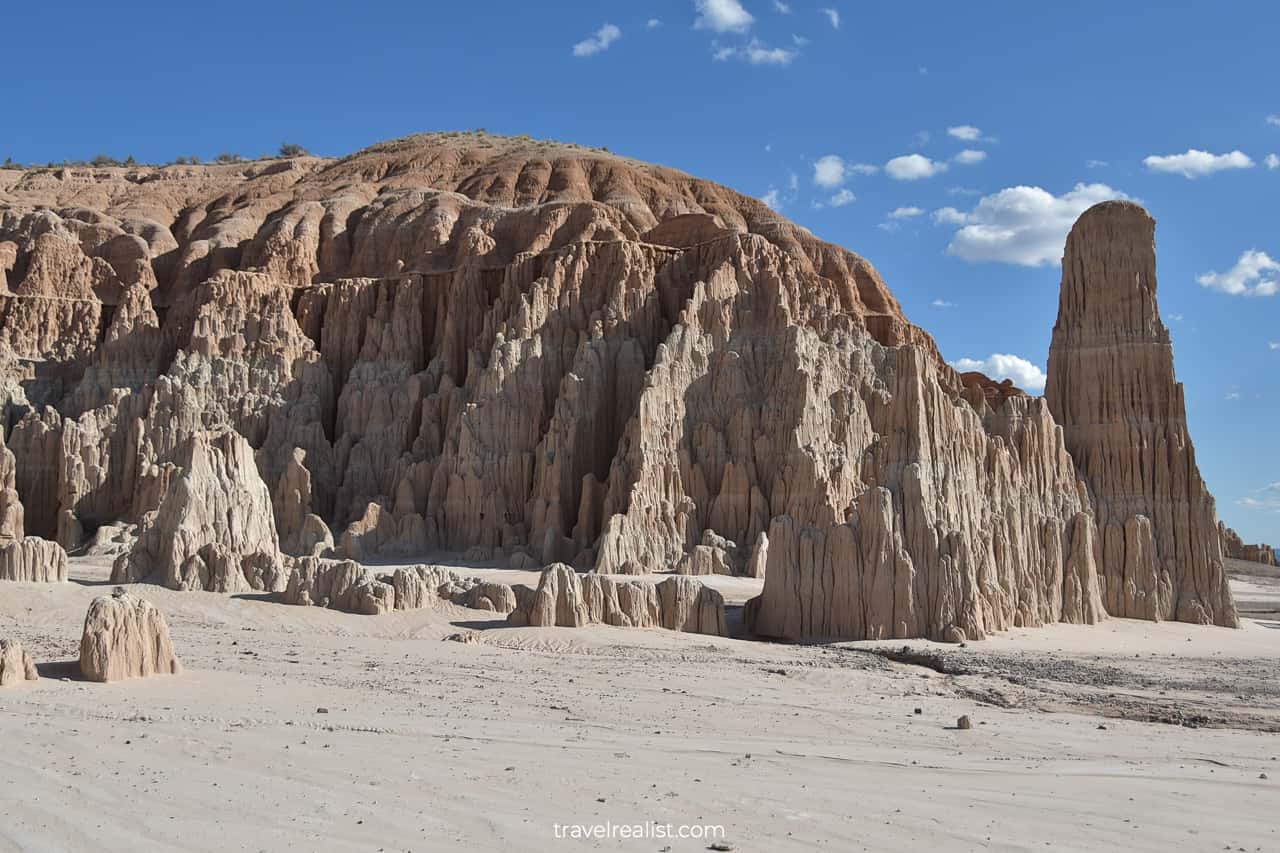
The outside of the Cathedral Caves slot canyon looks very similar to the Canyon Caves.
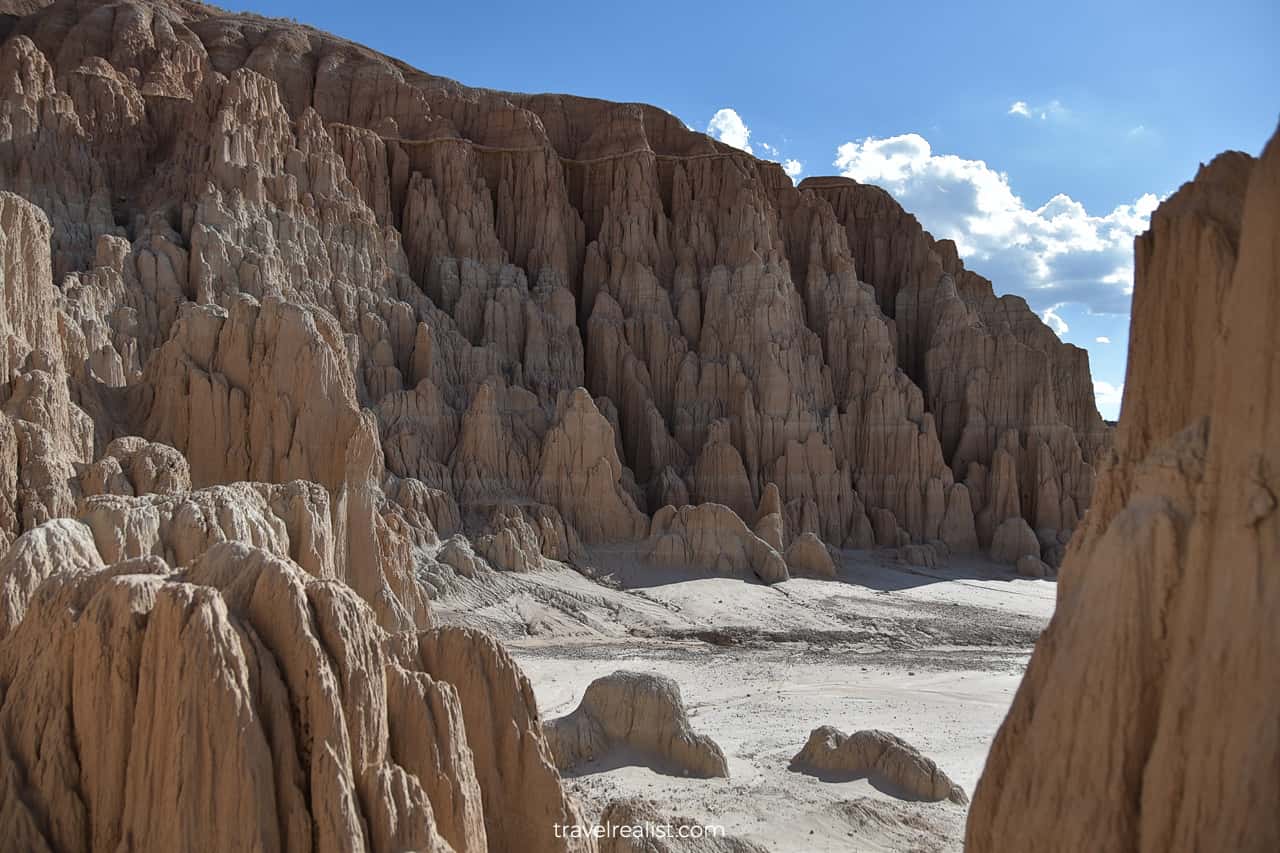
Despite all the markers, the Cathedral Caves entrance is very inconspicuous and hidden in the landscape. It took us a few moments to locate the canyon entrance and start the exploration.
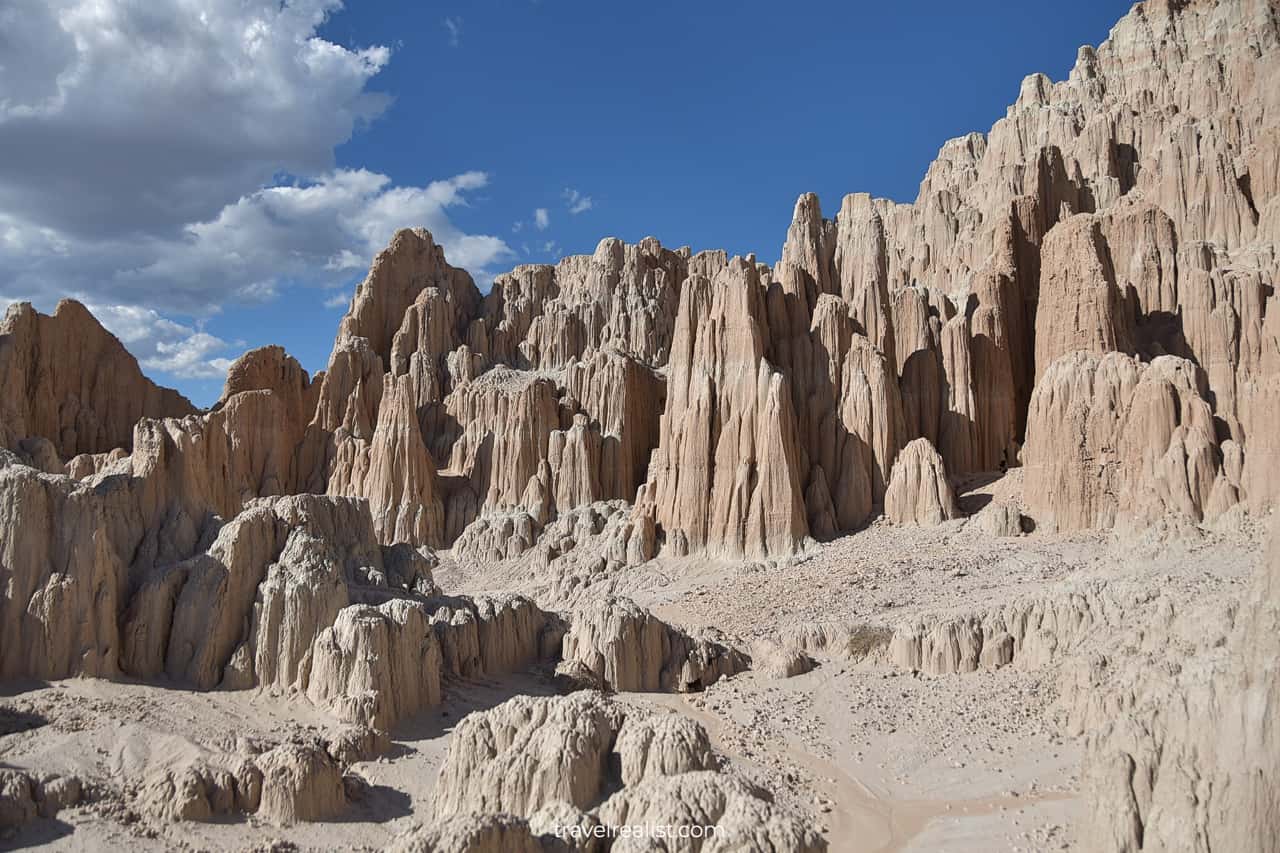
Once we entered the Cathedral Caves, we encountered a large slot canyon and cave system. There were about four to five canyon offshoots that differed in length and width.
This canyon felt a bit like a labyrinth due to a variety of paths to choose from.
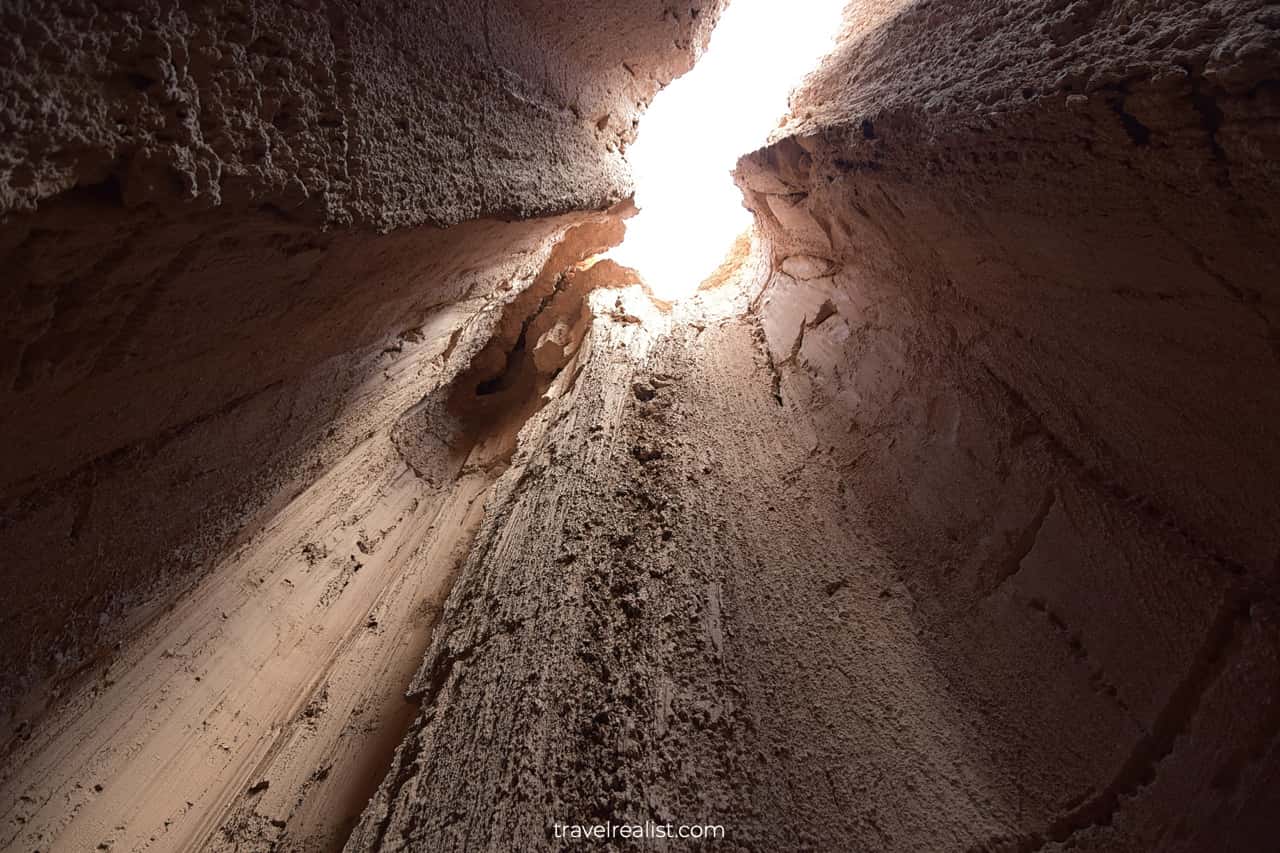
The Cathedral Caves featured some of the narrowest paths in the whole state park. The canyon floor was so narrow that it sometimes could not accommodate both feet next to one another.
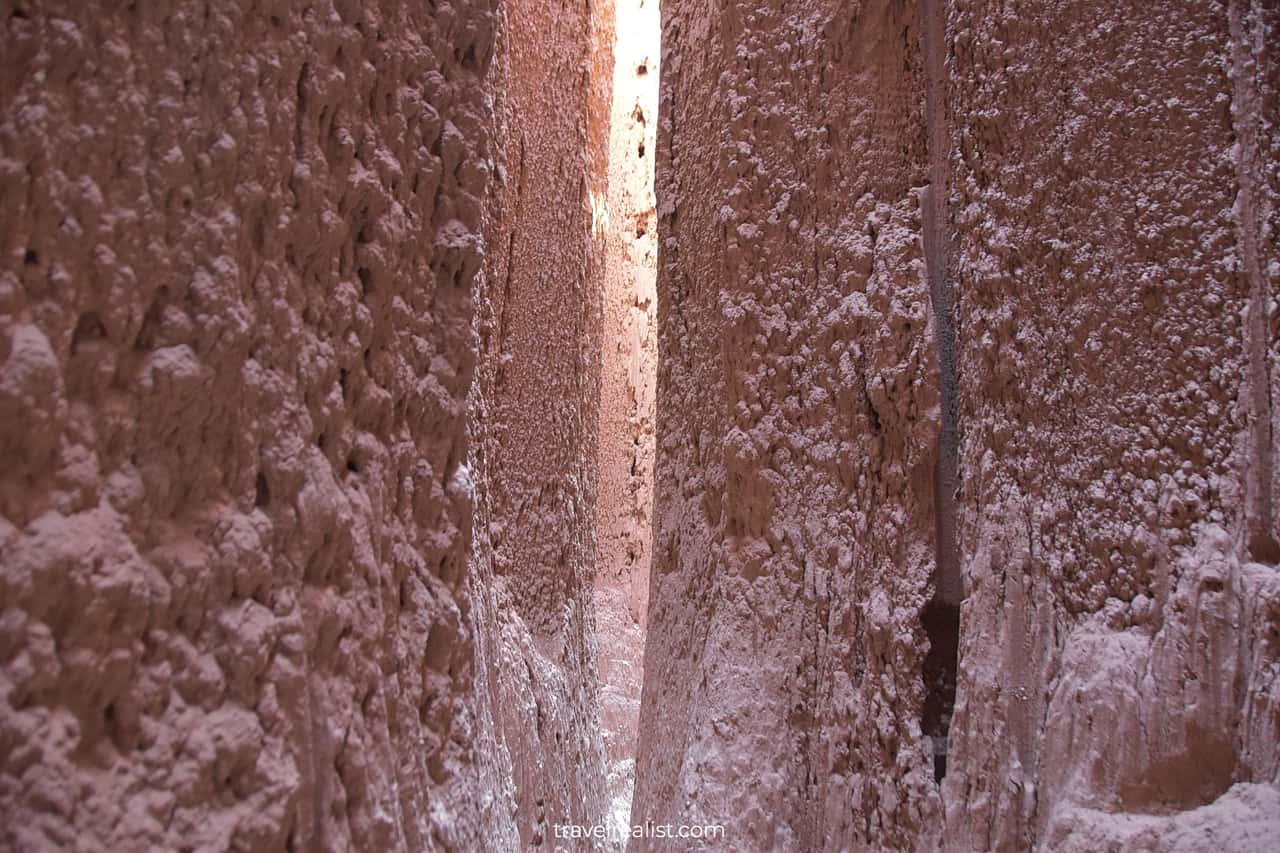
No matter which canyon offshoot we took, one thing always remained consistent. All canyon offshoots ended in a well or cathedral like structure.
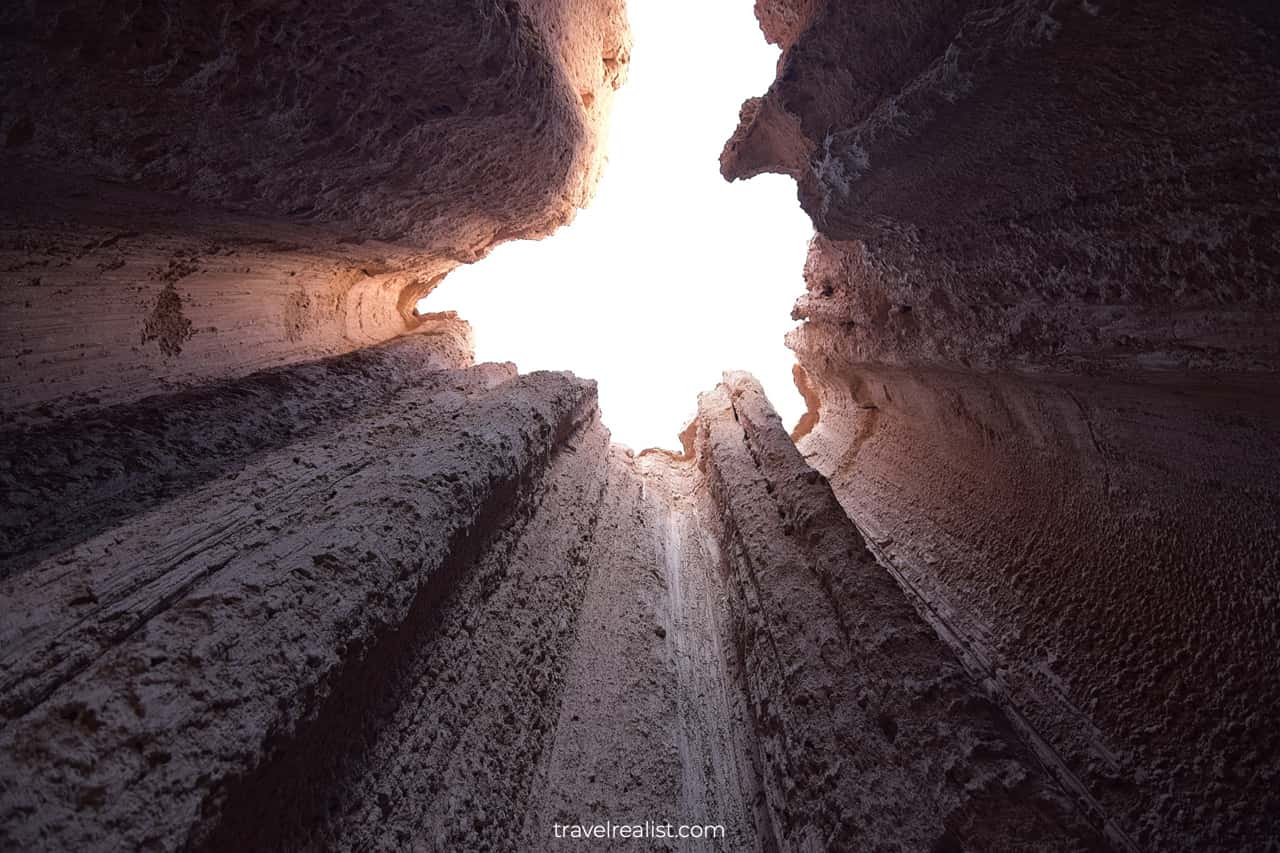
Once we exited the Cathedral Caves, we had one more location to explore in Cathedral Gorge.
Miller Point
Miller Point is a scenic overlook in the northern area of the state park. This overlook has its own entrance from the US-93 Great Basin Highway.
There are no roads connecting the slot caves with the overlook from within the park. You would have to leave and reenter the park if choose to drive to Miller Point.
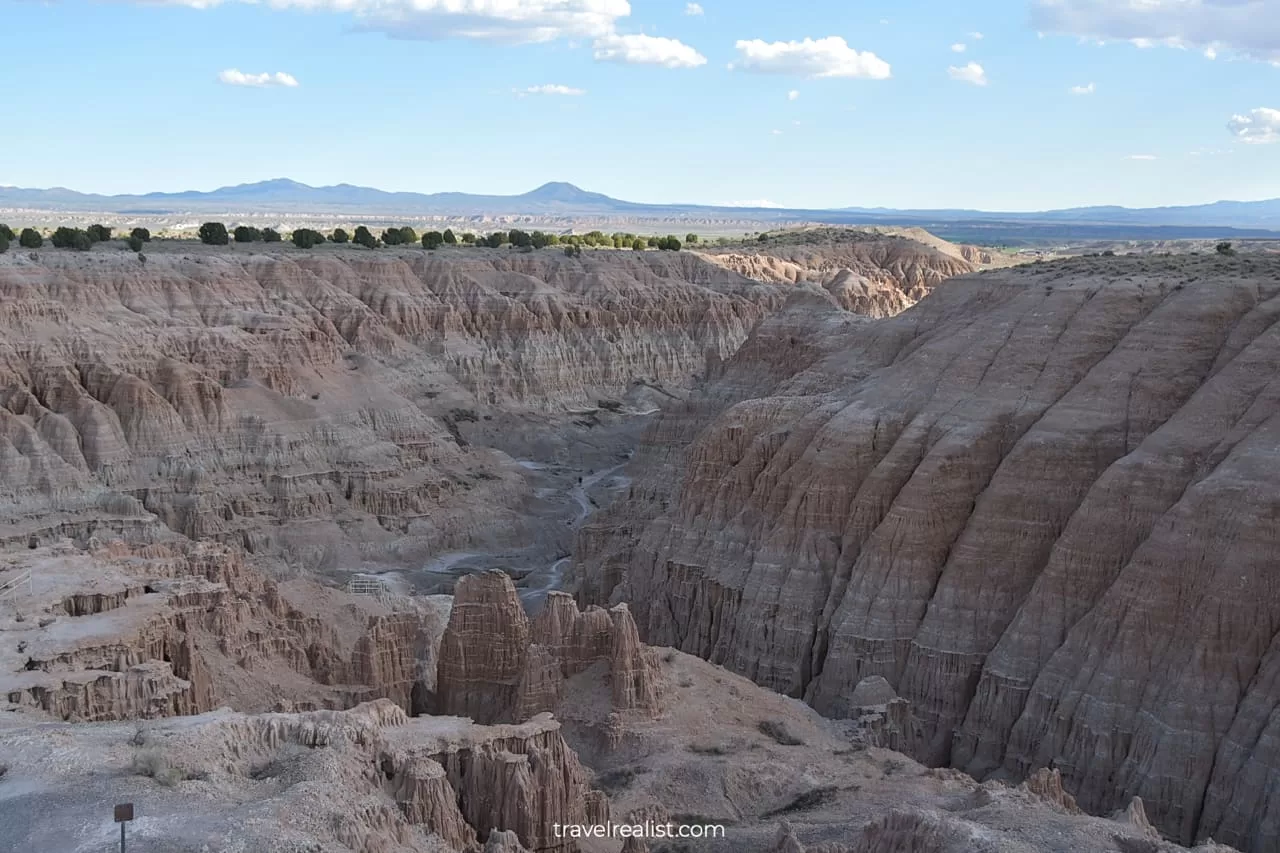
Miller Point features amazing views of the valley and surrounding landscape. The viewpoint is located atop of another cave.
The viewpoint features metal platforms and staircases to ensure visitor safety near numerous open wells and pits.
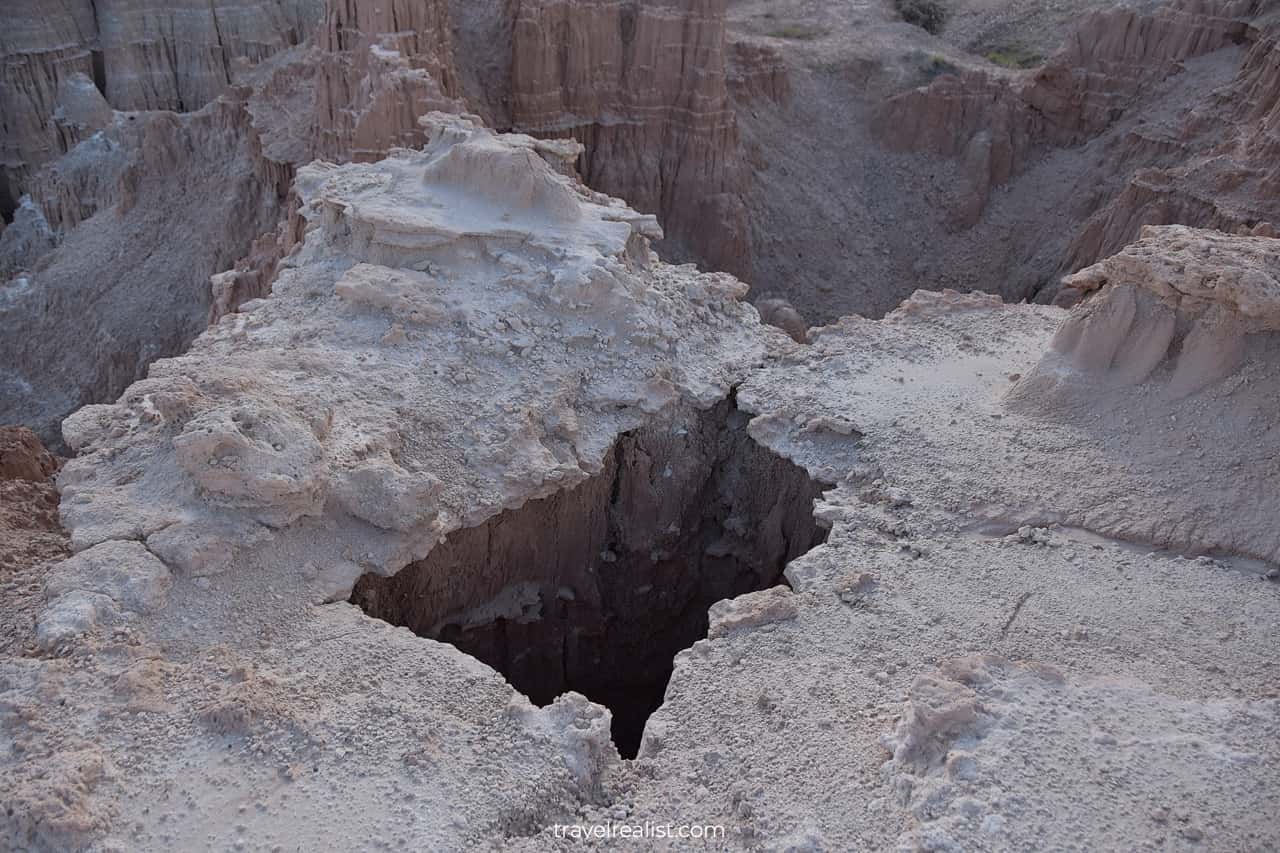
As we explored the viewpoint, we started to descend deeper into the valley.
Miller Point Trail
If we continued our descent we would have started the 1-mile (1.6-km) return Miller Point Trail. We would then reached the Cathedral Caves. Since we already explored that area of the park, we chose to hike back to the parking lot.
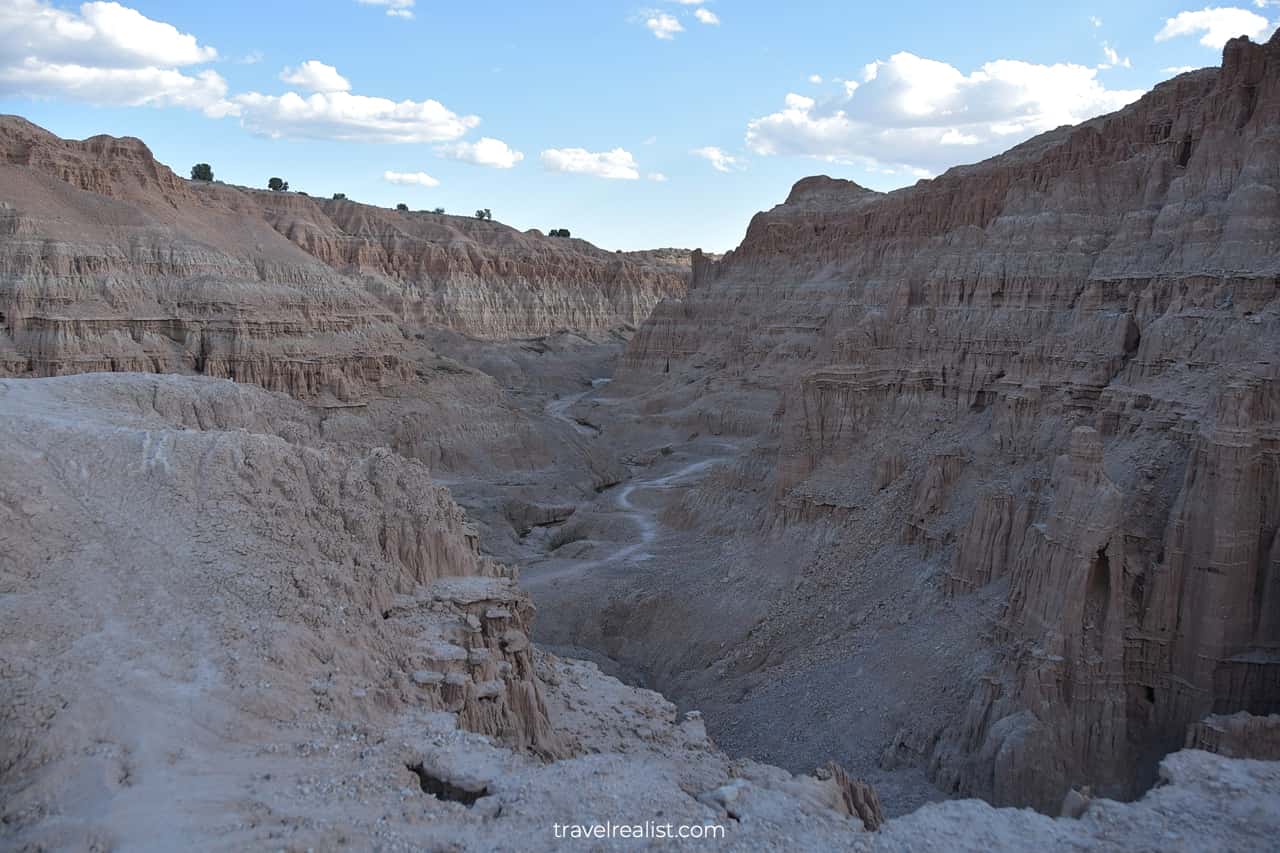
Continue with our Cathedral Gorge Guide to learn more about ways to get to the sights, entrance requirements, and places to stay.
Getting to Cathedral Gorge
Cathedral Gorge State Park is in a fairly remote area of Nevada. While the park appears fairly close to major cities on a map, the driving times are long.
- It takes 2.5 hours to reach the park from Las Vegas, NV would take about 2.5 hours.
- A drive from Salt Lake City, UT would take over 5 hours. But you could visit Great Basin National Park on the way.
- St. George, UT is the closest large city to Cathedral Gorge. Yet, you would still need almost 2 hours to reach the park.
Once you budget time for a return journey, Cathedral Gorge could become your main attraction of the day.
On the bright side, this remote location ensures that you can enjoy the canyons and formations in solitude. This is a strong selling point of Cathedral Gorge. It sets it apart from other slot canyons in the Western United States.
Where to Stay
Finding places to stay near Cathedral Gorge State Park is very difficult. Although the park neighbors the town of Panaca, NV, there are not many places to stay.
In fact, your best bet might be to book a place to stay in St. George, UT or Hurricane, UT. These cities have plenty of properties to choose from based on your budget.
Staying in Southwestern Utah could enable you to visit additional parks, like Zion National Park and Snow Canyon State Park.
Entrance Requirements & Passes
Cathedral Gorge State Park is open year round 24 hours a day. It is still a good idea to visit the park during daytime. This way you can get the most from your visit to the slot canyons, trails, and viewpoints. We visited Cathedral Gorge during our fall trip to Nevada and Utah.
Cathedral Gorge charges admission fees that differ based on the visitor’s residency.
- Nevada residents would pay $5 per vehicle.
- The same day pass for non-Nevada vehicles would be double the amount at $10.
- You can save a bit and pay $2 if you bike into the park.
All fees are accurate at the time of writing.
If you plan on visiting several Nevada state parks, you could buy an annual pass. The cheapest Nevada annual entrance permit costs $100. It takes about 6-7 state park visits to pay for itself.
Takeaways: Cathedral Gorge
Cathedral Gorge State Park is a beautiful park in Eastern Nevada. The park lures visitors with an unbeatable deal.
- You can explore magnificent slot canyons and clay spires for $10 or less.
- You can take pictures without crowds
- And you can discover formations at your own pace.
The park’s remote location and limited nearby places to stay are the only downsides for a visit.
However, Cathedral Gorge should be on your list if you are looking for a cost efficient alternative to Antelope Canyon.
Take a look at our Cathedral Gorge Video Guide and visit our YouTube channel for the latest videos.
Frequently Asked Questions
Cathedral Gorge is know for scenic clay caves and slot canyons.
Fall and spring are the best seasons to visit Cathedral Gorge State Park. This way, you can explore the slot canyons without excessive summer heat and avoid winter road flooding.
Cathedral Gorge State Park protects an area of about 3 miles in length. The majority of slot caves and canyons are located along the one mile stretch.
Volcanic activity and erosion created the formations in Cathedral Gorge.
Safe realist travels!


